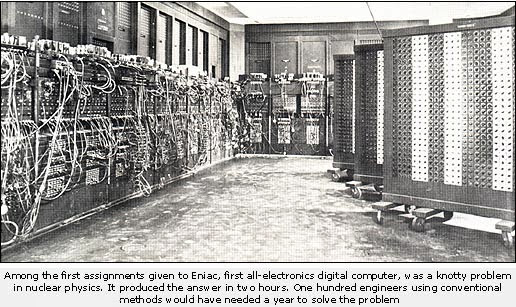
Information Technology It
The first computer was made in 1946 at the University of Pennsylvania. ENIAC (Electronic Numerical Integrator And Computer) contained 18,000 vacuum tubes, it was 30 tons heavy and occupied the space of 154 m2.
First Generation computers are characterised by the use of vacuum tubes. These vacuum tubes were used for calculation as well as storage and control. Later, magnetic tapes and magnetic drums were implemented as storage media. The first vacuum tube computer, ENIAC, was developed by US army ordinance to calculate ballistic firing tables in WWII. It had about 17 000 vacuum tubes. The machine weighed 30 tons, covered about 1000 square feet of floor, and consumed 130 or 140 kilowatts of electricity. The ENIAC's clock speed was about 100 kHz. In addition to ballistics, the ENIAC's field of application included weather prediction, atomic-energy calculations, cosmic-ray studies, thermal ignition, random-number studies, wind-tunnel design, and other scientific uses. No electronic computers were being applied to commercial problems until about 1951.
Vacuum tube circuit
This is an example of a vacuum tube based circuit used in a first generation computer (a Burroughs), pictured here next to a transistor based circuit, with similar functionality, from a second generation computer (the IBM 1620). The vacuum tubes (at the top of the circuit) have been damaged because of overheating. We suspect that this particular circuit is a 4-bit register. Circuits created i this way were extremely bulky. To create a 32-bit ADD circuit would require 800 logic gates using a total of 1,504 transistors. In vacuum tube based computers, this many vacuum tubes would take up a space about the size of a refrigerator.
Vacuum tube
This is a small vacuum tube, used in first generation computers.
Here you can clearly see the effect of overheating, leaving a black stain on
the inside of the glass tube. Constant overheating and burnout in the vacuum
tubes of ENIAC, the first electronic computing device, in 1947 led AT&T Bell
Telephone Laboratory engineers John Bardeen, William Shockley, and Walter Brattain
to seek out a suitable alternative for the commercially unreliable vacuum tube.
The three successfully demonstrated the principle of amplifying an electrical
current using a solid semiconducting material, silicon, forming the basic concept
behind the transistor.



No comments:
Post a Comment